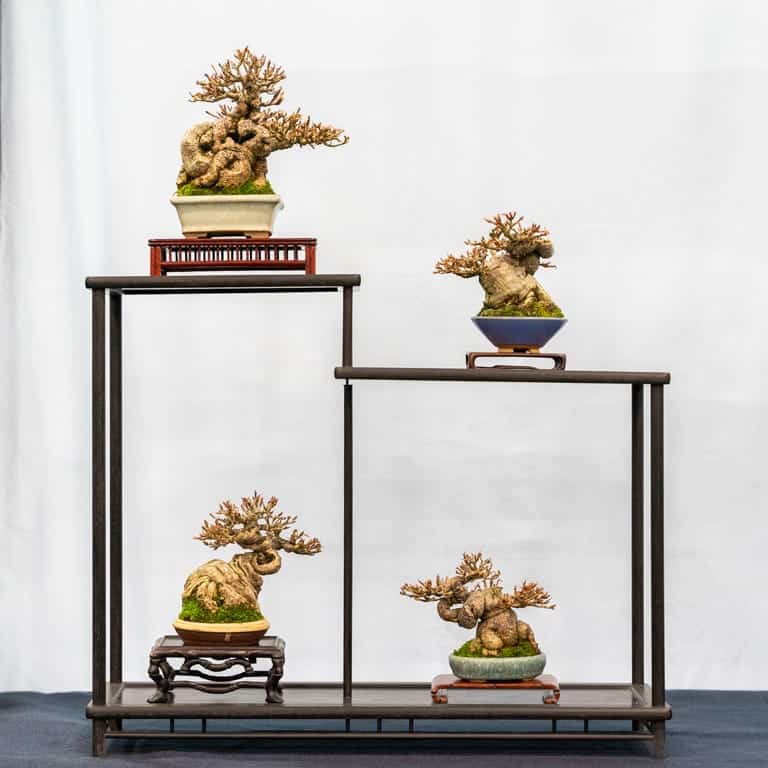Our third installment of the US National Bonsai Exhibition wrap-up focuses on shohin. This year’s exhibit featured 120 of them!
If you’re interested in learning about shohin and shohin display, check out the note following the post about registering for next year’s Shohin School Winter Seminar.

6-tree display by John Kirby
Although it’s hard to see details in full-display photos, it’s relatively easy to consider the size and style of the trees, the shape and color of the containers, and the effectiveness of how the trees are arranged.

6-tree display by Gary Andes

5-tree display by Brian Hollowell

6-tree display by Melvyn Goldstein
One of the standout displays featured eight trees of the same species. While it’s common to feature a large number of mini-bonsai, it’s not as common for them all to be the same species.

Awesome 8-tree mini bonsai display by Suthin Sukosolvisit

Left-hand display stand

Center display table

Right hand display stand
In recent years, it’s become common to see alternative approaches to shohin display, whether with novel tree arrangements (as below) or with traditional arrangements but novel materials for the stands (the next display below that).
One thing I enjoy about novel approaches to shohin display is seeing which gain traction over time and which end up being one-offs as that’s a good measurement of community interest in given approach.

2-tree display by Pedro Morales

6-tree display with metal stands
We’ll touch on the topic of alternative shohin displays at next year’s Shohin School Winter Seminar. See details below.
Registration Open for Shohin School 2024 Winter Seminar!
Andrew Robson, Daisaku Nomoto, and I will host the second Shohin School Winter seminar at the Milwaukie Center, just south of Portland, Oregon, on January 26-27.
This year’s event will reinforce topics addressed at last year’s seminar and introduce new topics and a demonstration by Daisaku. As always, there will be opportunities to work on your trees, practice creating shohin displays, and shop from a great assortment of shohin vendors (the complete vendor list will be available soon).
On the day before the seminar, David Knittle is hosting a build-your-own stand workshop. The event is nearly sold-out, but I’ll be sure to post a note if additional space opens up.
Helpful links:
- Recap of last year’s event including video highlights
- Information about Shohin School
- Register for Shohin School
Subscribe to Bonsai Tonight
New Posts Delivered Every Tuesday and Friday
Julian Duval says
What are the thick trunk leafless trees that look like succulents?
Jonas Dupuich says
I don’t remember, it could be ficus.
scott chadd says
Jonas, are the bonsai in Suthin’s exhibit Chinese Elms, Figs, or some other material.? I would bet you that these are imported from Asia. it is very difficult to find material such as this in the US.
Jonas Dupuich says
Ficus is my best guess – and that’s right about the lack of good ones developed in the US. Suthin makes fantastic trees so it could be either way with these.
Ondrej Nemec says
Hi Jonas, as always superb quality of tress on exhibition. Thank you. I have question, which kind of the trees are in Suthin´s display? Thank you for answer. Ondrej
Jonas Dupuich says
Thanks, Ondrej! I’m not sure about Suthin’s display, they may be willow-leaf ficus.
Richard Dorfman says
This may be controversial, but to me displaying Shohin trees in groups takes away the beauty and individuality of each tree. Not a single tree above strikes me as being unique or special…at least when displayed in this manner.
Greg Wade says
I wholeheartedly agree with Richard. I appreciate the artistry in this type of display, but they all start looking the same after a while. And the individuality of each tree is totally lost. I love the shohin size, but not displayed in this traditional way. I know this is a minority viewpoint….
Christian says
That’s unfortunate you can’t appreciate the understanding and mastery it take to put together this kind of display or create this many style variations of this species with fine ramification. However, instead of focusing on the species, rather use it as a example in display, particularly the flow of one element in the display to another and the harmony of a different container sizes, shapes and color.
Greg Wade says
Another way to look at it is to look at the picture of Suthin’s right hand circular display stand. Absolutely stunning! Then compare that image to the total display with the left, right and center elements.
Just one perspective….